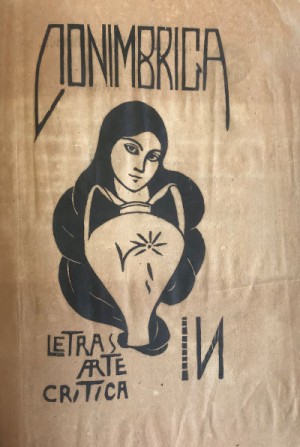
Comparing, for instnce, with Nova Phenix Renascida (1921), Conímbriga (1923) is a graphically more advanced magazine. The name and cover image, by Germano Vieira, clearly refer us to the universe of the Coimbra tradition, to a certain nostalgia for the mythical past, which will be clearly shown here in a poem like "Saudade", by Valdemar Lopes, today an unknown name. Echoes of this graphics will be felt in an interesting Coimbra magazine the following year, Tríptico (especially the second issue).
In the editorial, entitled "Before...", two principles are made clear: first, we are dealing with a group of young people, a youth magazine, which defends not having reformist intentions or coming to announce "a new school, seeking out the castaways of modern art". And, secondly, with a clear purpose of making better known the artistic talent that the city of Coimbra has produced.
The following text, written by A. Augusto Gonçalves, seems to be an ontological contradiction of the editorial's text, stating at the start that "This title Conímbriga is a program". It is an embattled text, attacking the destruction of the urban heritage of the city of students, stimulated by intense touristification. The indignation, however, of Gonçalves is towards a decree-law that diminishes the strategic importance of Coimbra, bringing it alongside less important places in Portugal such as "the Termas dos Cucos and Unhais da Serra!".
The modernist portrait of the Spanish thinker Miguel de Unamuno, by Vázquez Díaz, future contributor to Contemporânea, should be highlighted throughout the magazine. This painting appears here as a paradigm of Díaz's artistic exceptionality, since he is the protagonist of a more or less extensive article by Vitorino Nemésio, who is in that city completing his course in Historical-Philosophical Sciences.
This is, therefore, a magazine that did not have more than one number, but which right away in the index announces who will be the next contributors: Raul Brandão, João Ameal, among others. Taking into account the difference in the invectives of the magazine's first two texts, it can be assumed that the magazine has not been able to take it forward due to the inexistence of a synthesis of the two impulses (reformist and conformist) that command all these modernist magazines.
Ricardo Marques
